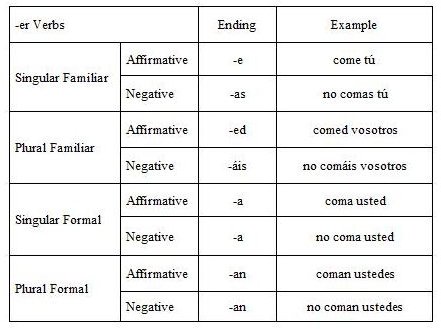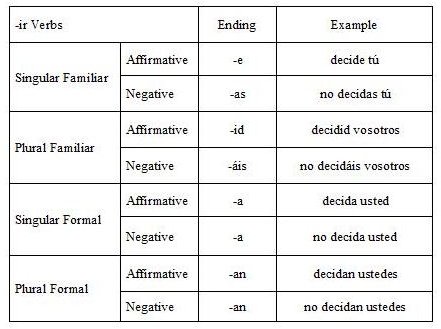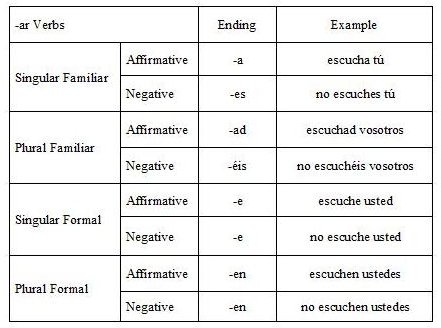How to Teach Commands to First Year Spanish Language Students
Imperative Mood Lesson Plan
The following lesson plan can be used by Spanish teachers to introduce the imperative mood to English-speaking Spanish students. The first part introduces the imperative to students by explaining the use of the verb form in English. The second part describes how to form the imperative in Spanish and includes charts for each verb type and useful tips.
The Imperative Mood in English
Use as much or little of this section for your students as you think the class needs. It is material they should know, but they may not have paid attention to the material in their English grammar studies.
Begin by discussing the imperative mood in English. Explain that the imperative mood is a verb form in English that speakers can use to make direct commands, express requests, and grant or deny permission. For example, the following sentences contain verbs in the imperative mood:
- Stop! (command)
- Sit down! (command)
- Please open the window. (request)
- Please wash the dishes. (request)
- Go to the party. (grant permission)
- Pet the puppy. (grant permission)
- Do not eat the cookies! (deny permission)
- Don’t take the car out tonight! (deny permission)
Formation of the Imperative in English
Discuss the formation of the imperative in English. The English imperative form is identical to the base form of any English verb. The base form of an English verb is the infinitive without the preposition to functioning as the infinitive marker. For example, the following chart identifies the infinitive, base, and imperative forms of some common English verbs:
Infinitive – Base – Imperative
- to be – be – be
- to eat – eat – eat
- to drink – drink – drink
- to read – read – read
- to write – write – write
- to sit – sit – sit
- to give – give – give
- to go – go – go
The negative imperative in English is formed by inserting the do operator and the adverb not before the base form of the verb. The operator and adverb are usually combined as the contraction don’t in spoken English. For example, the following sentences contain negative imperatives:
- Do not steal.
- Do not tease the cat.
- Do not forget to site your sources.
- Don’t spill the beans.
- Don’t eat cookies in bed.
- Don’t tell your mother.
Grammatical Subject and Word Order in English Imperatives
The grammatical subject of imperative sentences in English is always the second person personal pronoun you, either singular or plural. Unlike declarative and interrogative sentences in English that must contain a stated grammatical subject, English imperatives usually contain an understood you. An understood you is defined as a you that functions as the subject of an imperative sentence but is not implicitly stated. Or, the pronoun you is understood to be the subject of the sentence.
However, the pronoun you can be inserted back into imperative sentences in English. The word order for an imperative sentence with a stated you subject is the same as for a declarative sentence in English. The word order for an imperative sentence with an understood you subject is also the same as for a declarative sentence in English except that the you is omitted. For example, the following sentences are examples of English imperatives:
- Sit.
- Be quiet.
- You hush up.
- Clean your room.
- You take a shower right now.
- You watch your language.
- Please buy me a soda.
- Paint the barn red.
Commands in Spanish
Introduce the imperative mood (el imperativo) in Spanish. Explain that the imperative mood is similarly used in Spanish to make direct commands (mandatos directos), express requests, and grant or deny permission. For example, the following Spanish sentences contain verbs in the imperative mood:
- Lava por favor los platos. “Wash the dishes please.”
- ¡Bebed la leche! “Drink the milk!”
- Visite la biblioteca. “Visit the library.”
- Escuchen el professor. “Listen to the teacher.”
General Rules for Forming the Spanish Imperative
Explain the general rules for forming the imperative in Spanish.
- Four different forms exist for the familiar tú and vosotros commands: singular affirmative, singular negative, plural affirmative, and plural negative.
- All of the familiar commands are formed by first removing the infinitive ending (-ar, -er, -ir) from the verb and then adding the appropriate imperative ending.
- Two different forms exist for the formal usted and ustedes commands: singular and plural.
- All of the formal commands are formed by conjugating the verb into the first person singular present indicative form, removing the -o ending, and then adding the appropriate imperative ending.
-ar Verbs
Introduce the imperative forms of the -ar verbs. The following chart illustrates the endings for -ar verbs in the imperative with examples:
-er Verbs
Introduce the imperative forms of the -er verbs. The following chart illustrates the endings for -er verbs in the imperative with examples:

-ir Verbs
Introduce the imperative forms of the -ir verbs. The following chart illustrates the endings for -ir verbs in the imperative with examples:

Irregular Verb Forms
Discuss the eight common verbs that have irregular singular affirmative imperative forms. The following Spanish verbs have irregular affirmative tú commands in the imperative mood:
- decir – di
- hacer – haz
- ir – ve
- poner – pon
- salir – sal
- ser – sé
- tener – ten
- venir – ven
Familiar or Formal?
Explain the difference in use between the familiar and formal forms of the imperative mood in Spanish. The second person pronouns tú and vosotros, which are both you in English, are familiar forms. Familiar forms should be used only with family members, close friends, children, peers, and animals. For example, habla “speak” can be said to a student by a teacher or to a child by a parent.
The second person pronouns usted and ustedes, which are both are also you in English, are formal forms. Formal forms are always used with strangers, casual acquaintances, superiors, professional colleagues, people with formal titles, and others not well know to the speaker. For example, beba “drink” can be said to a supervisor by an employee or to a parent by a child.
Subject Pronouns with Spanish Imperatives
Explain the use and position of subject pronouns with the Spanish imperative. The grammatical subject of imperative sentences in Spanish is also always one of the four the second person personal pronoun: tú, vosotros, usted, and ustedes. Similar to the optionality of the understood you in the English imperative, the subject pronoun is also optional in the Spanish imperative.
However, the subject pronouns can also be inserted back into Spanish imperative sentences, especially in the formal forms to make the commands more formal or more polite. Unlike the word order of Spanish declarative sentences (subject-verb), the word order for imperative sentences in Spanish with stated subjects is verb-subject. For example, the following sentences are examples of Spanish imperative sentences with stated subjects:
- Pregunte usted. “Ask.”
- Crea usted. “Believe.”
- Olvide usted. “Forget.”
- Expliquen ustedes. “Explain.”
- Aprendan ustedes. “Learn.”
- Miren ustedes. “Look.”
Related Articles
- Pronoun Use and Written Accents for Spanish Commands
- Tips and Activities for Teaching Spanish Commands
- Learning How to Form Spanish Commands
For more Spanish lesson plans, please refer to:
